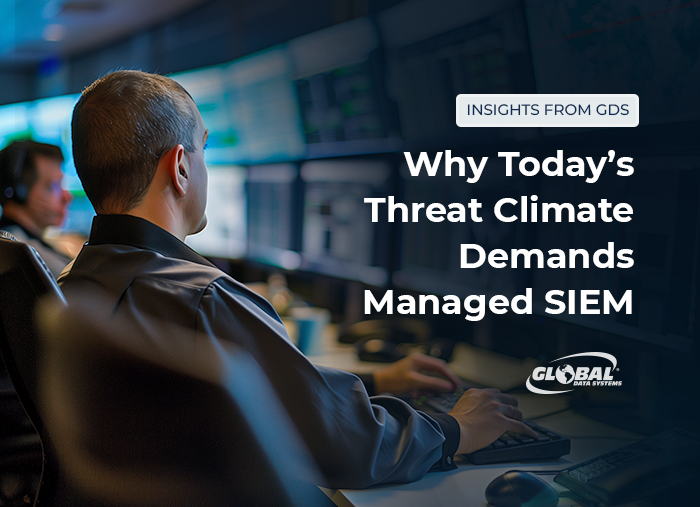Why Today’s Threat Climate Demands Managed SIEM
Cybercriminals are developing more sophisticated threats and using automation to launch them in high volumes. In response, organizations are adopting more security tools to help them detect and respond to these threats. The problem is that these disparate tools don’t talk to one another, making it difficult to get a holistic view of the organization’s overall security posture. This challenge is driving increased adoption of security information and event management (SIEM) tools.

SIEM aggregates events and alerts from servers, networking equipment, end-user devices, security appliances and other sources. With SIEM, event logs and data are collected and stored in a central repository, where they are analyzed in near real time to detect unusual patterns and trends. This makes it possible to quickly identify and respond to threats more quickly. SIEM also correlates events, making it possible to detect relationships that could signal a security threat.
Verified Market Research expects the global SIEM market to see a compound annual growth rate of 9.5 percent through 2030. Heightened security threats, mobile and remote work styles, and stringent regulatory requirements are propelling this growth. Organizations also see SIEM as a cost-effective way to unify the security environment and increase IT staff productivity.
Benefits of SIEM
SIEM complements and enhances single-purpose security solutions by providing an overarching management layer. Data can be viewed through a single interface, enabling IT teams to make more informed decisions. In other words, security teams can focus less on individual security products and events and more on security analysis.
Best-in-class SIEM tools filter out false positives and use automation to minimize the number of duplicate and irrelevant alerts. This helps IT teams overcome “alert fatigue” and investigate suspicious activity more efficiently. They can also become more effective at assessing the impact of threats and enhancing the overall security strategy.
SIEM stands for Security Information and Event Management.
As important as SIEM is in today’s threat climate, many organizations struggle to take full advantage of its capabilities. Simply collecting the right data from each source is difficult, then comes the complicated task of correlating the various sources. As a result, SIEM can take a long time to integrate with existing systems. Add software and licensing costs to the time and resources required to set up and deploy the system, and SIEM can turn into an expensive project. And if the system isn’t properly tuned, IT teams can become overwhelmed with alerts that they cannot respond to and investigate.
Why Managed SIEM
Many organizations are turning to managed SIEM services to simplify SIEM deployment and management. With managed SIEM, a team of security experts handles the implementation of your SIEM system and provides ongoing administration and maintenance. Rather than hiring and training security personnel, you rely on the expertise of third-party professionals who have access to up-to-date threat intelligence and experience identifying and responding to a variety of security threats. At the same time, your organization will have access to all security data, event logs, reports and alerts, typically through a web-based portal.
Security point solutions play an essential role in detecting and responding to threats, but they don’t provide a complete picture of the overall environment. In order to take a more proactive approach to security, you need a holistic view of all security tools and data across your network. This can only be achieved by implementing and managing a well-tuned SIEM system. Managed SIEM services can simplify these processes and help your organization take full advantage of SIEM capabilities.
Benefits of Managed IT Services from Global Data Systems
- Strategic Managed IT: We help you solve your technology related business problems.
- Connectivity: We get you reliable, secure connectivity anywhere in the western hemisphere in 48 hours.
- Support: When you need help simply call our 24x7x365 support number.
- Billing: Instead of managing hundreds of vendors - get one, easy to read bill from GDS.
Contact Managed Services Provider, Global Data Systems >

